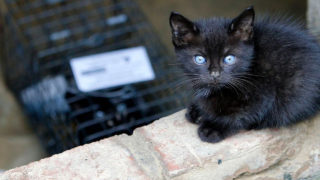Alley Cat Allies is preparing the Boardwalk Cats in Atlantic City, New Jersey, for colder weather, and we know we’re not alone. Wherever temperatures are dropping around the United States, caregivers are taking extra steps to help outdoor cats in winter, making sure they stay safe and comfortable.
Whether you feed a colony or carry out Trap-Neuter-Return (TNR) in your community, consider these top moves to help outdoor cats as winter weather approaches:
- Provide a shelter. This will give cats somewhere to go to get away from snow, wind, and other elements. It’s relatively easy and inexpensive to build your own. You can also get ideas for shelters to buy or make in our shelter gallery. Plus, we have tips about what makes a good shelter and what doesn’t.
- Insulate cat shelters with straw, not hay. Straw repels moisture, unlike hay. Cats can burrow into the straw to stay dry and warm. Be sure to keep adding straw throughout the season.
- Use a heated bowl for cats’ water and wet food. This will prevent them from freezing. Or, try this hack from Alley Cat Allies staff: Use rubber containers meant for horses. These won’t crack like plastic containers when water freezes in them.
- Build a feeding station. This will protect cats’ food and water from wind and snow.
- Provide food and water daily. Wet food and water can freeze overnight, so you want to ensure cats have access to fresh food and water every day. Cats eat more in the winter because they’re trying to conserve energy and stay warm. Consider giving them extra food.
- Prepare for major snowstorms. In the event a major weather event like snow accumulation is in the forecast, give cats extra food and water in case you can’t get to the colony.
- Clear snow from the entrances of cats’ shelters after snowstorms so they don’t get snowed in.
- Don’t use salt or chemical melting products to clear snow. They can be lethal when licked off paws or ingested from melting puddles. They are also harmful to cats’ natural snowshoestheir paws!
- Keep antifreeze away from cats. Antifreeze is poison. Animals, including cats, find its taste irresistible. As little as a teaspoon of auto antifreeze spilled in your driveway can be fatal for a cat.
- Always check under the hood of your car for cats. Before you turn on your car engine, look under your car to make sure the coast is clear, and check to see that no cats have curled up in your engine during especially cold days. Give the hood a few taps to make sure a cat isn’t hiding there.
If you’re carrying out TNR in the winter, keep this in mind: If it’s too cold outside for you, then it’s probably too cold for cats to be in traps, exposed to the elements, for extended periods of time. Keep traps covered and secured in a temperature-controlled vehicle or building.
Looking for more ideas about how you can help cats? Check out Alley Cat Allies’ Winter Weather Tips.

